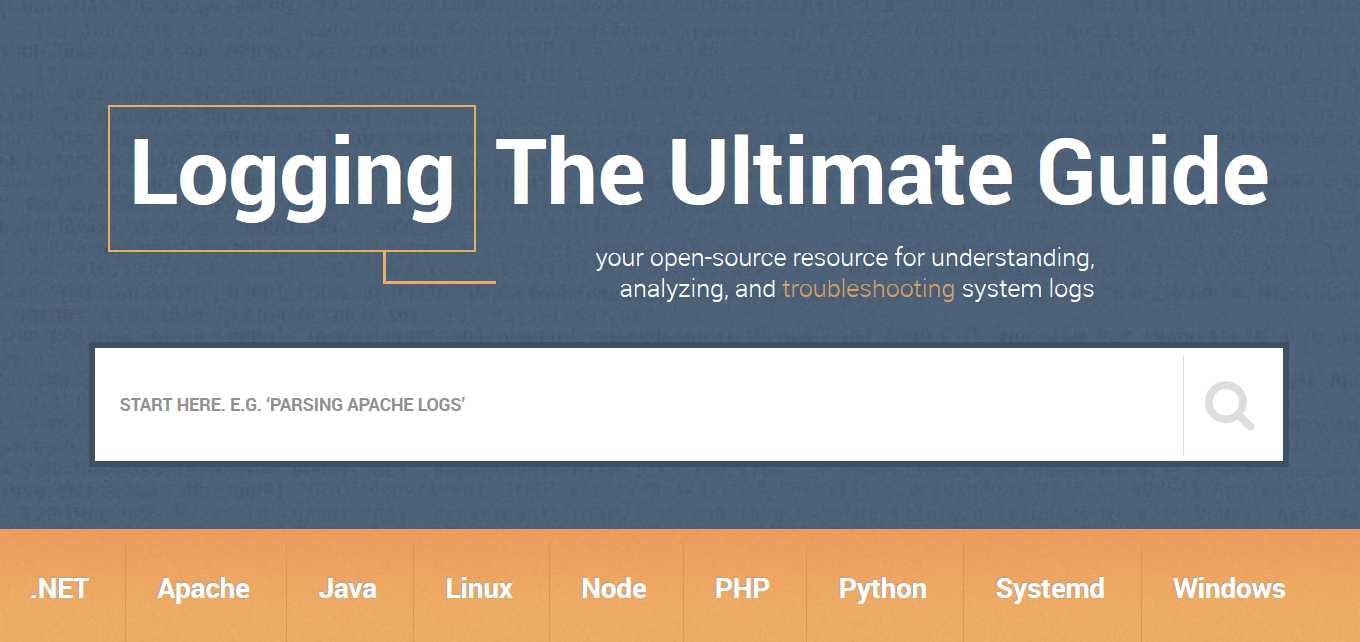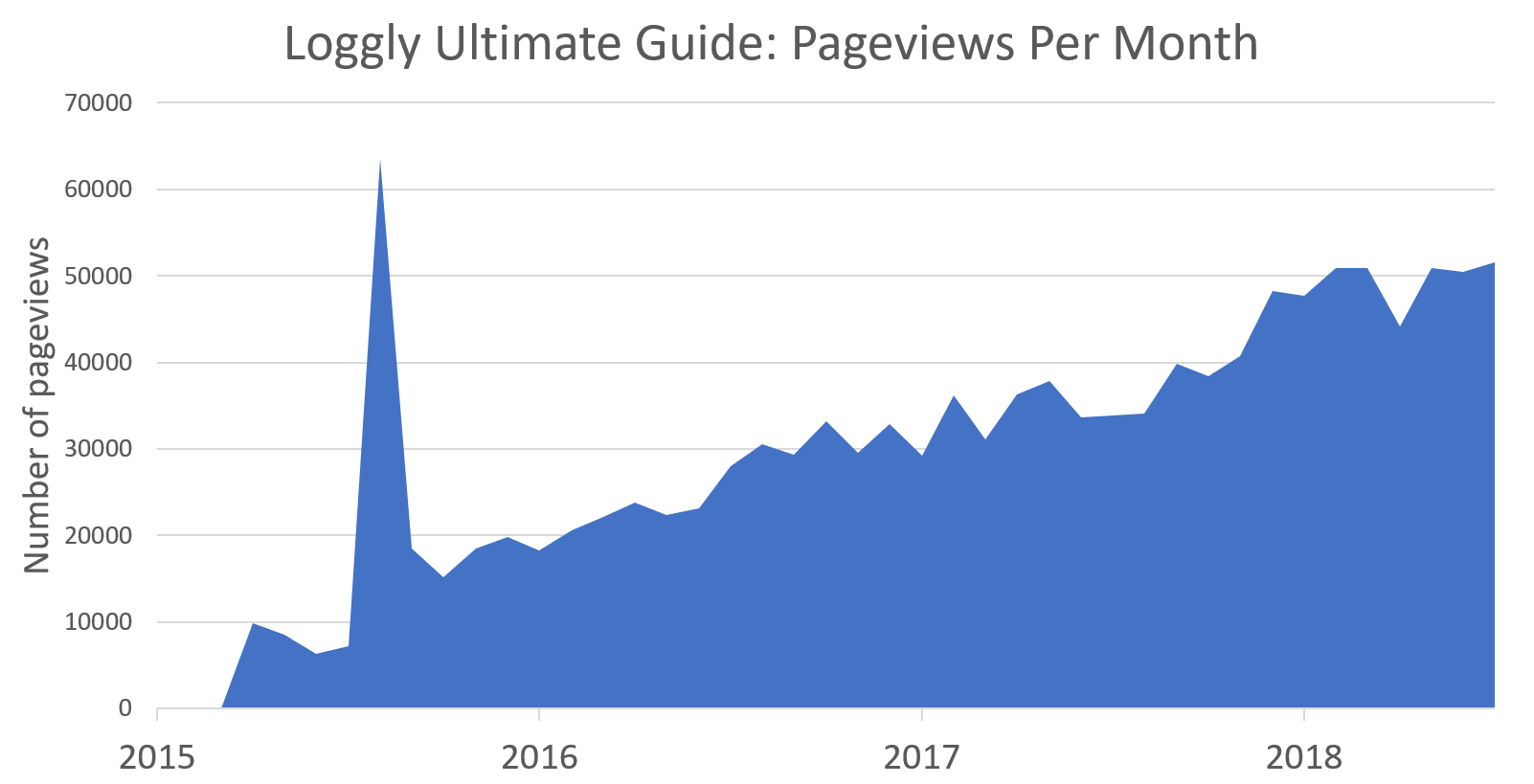“Ultimate guides” are online resources with in-depth educational content, and they are designed to generate leads through search engine traffic. The “Ultimate Guide to Logging” by SolarWinds Loggly® has generated over 1.2 million unique page views, which is impressive for its niche audience of software developers and ops engineers. For reference, the US Bureau of Labor Statics estimates there are 1.2 million software developer jobs in the U.S. The guide ranks No. 1 for many keywords like “Java logging” and “.NET logging”. Its traffic has grown consistently—around 50% year over year—with zero dollars spent on promotion. Learn how we built the guide and what made it successful.

“The ‘Ultimate Guide to Logging’ consistently ranks for seven of our top 20 pages overall, including our most popular blogs. The SEO equity boosts loggly.com to the top of SERPs for associated keywords. Jason and his team have done an awesome job!”
— Jake Dennison, Marketing Manager, SolarWinds
The Problem with Acquisition Costs
In 2015, Loggly was a venture-backed startup selling a log monitoring service to software developers and DevOps engineers. It was growing revenue at a breakneck pace of 100% year over year. However, it faced competitors like Splunk, Elastic, and SumoLogic, all who raised several times more funding. Competitors were able to pay high bids for ads on search engines like Google AdWords, and Loggly couldn’t compete by outspending.
Loggly responded by making a major play on SEO. This leveled the playing field because success wasn’t determined by how much money was spent, but rather content quality. Jason Skowronski took the lead on creating a new ultimate guide, which turned out to be very popular and Loggly continued to grow. In 2018, Loggly was acquired by SolarWinds.
Why “Content is King”
High-quality content can drive traffic without the need for paid advertisements or promotions, especially articles that rank No. 1 on popular search engines like Google. While an advertisement is only visible temporarily, content is evergreen and can continue driving traffic for years. It also positions the company as an expert, builds a positive brand, and helps the community through excellent educational materials.
What is an “Ultimate Guide?”
While browsing the web, you may have run into long content pieces titled “the ultimate guide to X.” This type of content goes well beyond a typical blog article with deep educational information. The most successful ones span multiple pages and subtopics. You may not have realized that this was marketing material at the time, but it got you to learn more about that company and the problems they solve.
A major reason these guides are successful is they are optimized for search engines. They are written to cover the topics people search for and contain a deep collection of keywords. They send positive signals to search engines because great content means readers are less likely to bounce back to the results page. Additionally, since the content is educational, it’s great for backlinks and social sharing. Over time, the search engine will determine that the site is a good authority in this domain. This means any new or related content will immediately rank higher as well.
The Ultimate Guide to Logging
The Loggly ultimate guide provides information on logging from the most popular systems and programming languages, including Linux, Windows, Java, .NET, Node, PHP, Python, and Systemd. Each of these topics contains comprehensive information in four articles covering:
- A basic overview of what’s in the logs and where to find them
- How to search or analyze logs to find valuable information
- How to troubleshoot common issues and find the root cause
- How to centralize or aggregate logs in a large distributed system
The guide was published mid-2015 and it quickly picked up coverage on social media. There was a big spike in traffic that was a result of posting on Reddit and Hacker News. We reached the front page of Hacker News and the front page of several Reddit communities including r/sysadmin, r/homelab, and r/java. This drove about 65,000 views in a single month.

Reddit and especially developers dislike spammy content in community forums. However, if the content is valuable, then they will vote it up and even bookmark it. We love compliments like these.

We also received hundreds of additional backlinks from niche sites like ServerFault and PyPi, several translations, and coverage in newsletters like nixers and PHPDeveloper.
Traffic to the guide has increased steadily at about 50% year over year. If the current rate of growth continues, the monthly recurring traffic should exceed the initial social media spike in 2019. It continues to grow even though it required little effort to promote it.
What Made Loggly’s Guide Successful
- In-depth content written by expert practitioners Quality matters more than quantity. Do a simple Google search and you will often find millions of matches. You need to create content good enough to rank above all of them. Developers dislike marketing fluff and value content that speaks their language and teaches them something new. Be aware that there are many different communities and skill sets within the software development field. You wouldn’t hire a primarily backend developer to write about CSS or developing a mobile app. That’s why Loggly hired a dedicated team of experts for every topic in the ultimate guide.
- Topics selected based on search volume and conversions Loggly prioritized its ultimate guide topics based on user interest and search volume. The Loggly team analyzed which pages and keywords were driving the most traffic and resulting in the most customer conversions. This allowed Loggly to focus its efforts on systems and programming languages that are popular with our audience. Going a level further, we looked at queries within each topic to get a better idea around search intent and what kinds of questions that audiences are looking for. We made sure to cover those topics within our guides.
- Content optimized for search engines Loggly started writing each article with a list of target keywords and questions typically asked on social media or Q&A sites. This allowed Loggly to tailor its content based on search intent. Loggly made sure to use these keywords throughout the article including the title of the page, the headers and even images. Expert practitioners were also able to discuss each of these topics along with related keywords to provide the reader with richer context.
- Focus on education with a soft marketing touch We wanted to build the best guide to logging in the world and with the broadest reach. That’s why we made the guide open source and vendor neutral. This puts the focus on educating the reader and providing the best answers. When we discussed use cases, we showed solutions involving not just Loggly, but also the best open source solutions. We didn’t add in-your-face branding or pop-ups because readers will naturally see the advantages of Loggly as they learn about the available options.
- Positive engagement on social media Many developer communities have rules in place that prevent posting marketing material, and they will enforce it by downvoting and banning if necessary. The communities really seemed to value the educational and open-source nature of the guide. They responded by voting the guide up to the front page in several communities, which expanded exposure. This also led to a chain reaction where it was included in newsletters and other sites. The positive engagement on social media and backlinks helped our search ranking as well.
Create Your Own Ultimate Guide
You can start a successful ultimate guide by researching your audience’s needs. It’s important to know what type of information readers are looking for. Look at search volumes, questions posted online, interactions with your own customers, and more.
You should also consider the design and information architecture for the guide. A navigation system, header styles with anchor links, and more can be important to help readers find the right content without bouncing back to the search engine. Links to see follow-on content can help pull them deeper into the site and even learn about your product.
Next, you need to assemble a team of domain experts to write the content. These writers should be specialists in each of the topic areas and able to cover the material in-depth. They should know what readers will be most interested in learning, and all the related topics necessary to achieve a solution.
It’s helpful to have a system to organize writers and ensure a reliable delivery schedule. You will need editors to approve outlines, review drafts, and do final polishing. You will need to organize your designers and developers to create the layout of the guide. You’ll also need people focused on developer evangelism and community management to promote the guide.
You might also want to consider hiring an agency to get expertise on content strategy and execution. Jason Skowronski led the creation of the Loggly Ultimate Guide to Logging. He founded Dev Spotlight to help other companies reach developers. Our services include consulting on content strategy, and our agency has dozens of expert software developers and DevOps engineers available for technical writing. Contact us to discuss how we can help create your own ultimate guide!

